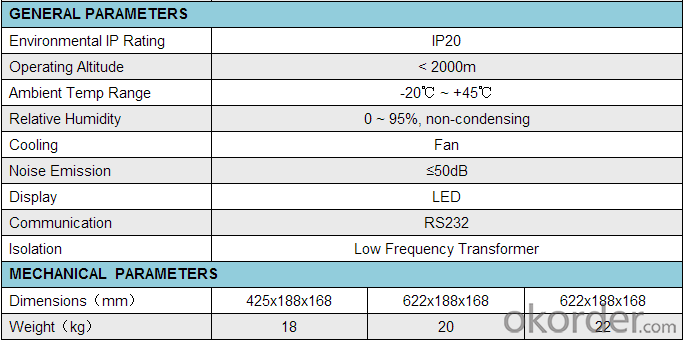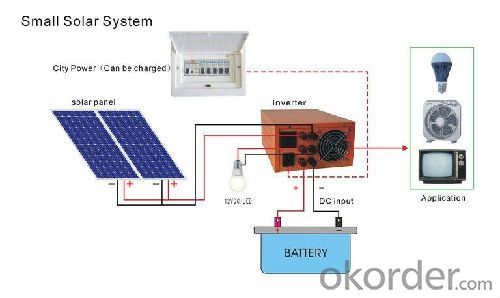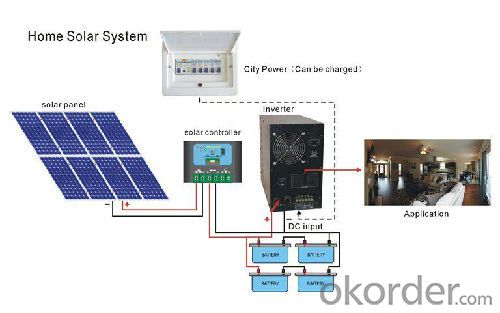ESA-1K/2K/3K-Inverter/Charger Pure Sinewave Output with LF Transformer
- Loading Port:
- Shanghai
- Payment Terms:
- TT or LC
- Min Order Qty:
- 100 pc
- Supply Capability:
- 100000 pc/month
OKorder Service Pledge
OKorder Financial Service
You Might Also Like
Technical Features

Pure sinewave output
Input/output full isolation with LF transformer
Enhanced digital control techonology
High reliability with full protection functions
Built-in multi-stage AC charger
High surge capacity
Automatically transfers AC input power from inverter output
1. SX/SXN Series is a Sophisticated Solar Charge Controller Which Offers Exceptional Features at an Extremely Competitive Price;
2. Data Logging
The SX/SXN charge controller stores system data for one year;
3. High Reliability Design
Superior design ensures high degree of reliablity through PCB conformal coating and anti-corrosive screws and terminals. Full electronic protection againsst short circuits, overload, overcurrent, reverse flow, wrong polarity and over-temperature;
4.Multifunctional LCD Display
The SOC bar indicates the exact state of charge(available energy)as a percentage through the battery gauge symbol. Load status and nightlight function are displayed symbolically;
5. Negative Grounding(SXN);6. Positive Grounding (SX);
7. Various Optional System Accessories;
8. Overcharge Protection;
9. Overdischarge Protection Selectable LCD Modes.


FAQ
Q: What is the warranty of this product ?
All the products have one year warranty.any quality problem not contain the manmade damage. For the details please contact with me.
Q: The product can be costomzied logo printing?
Yes, we have focused on solar charger and power bank for 8 years, OEM is welcome.
Q:What is the charging conversion rate ?
The charging convesion rate is 75%~80%.but when you charging mobile phone you may feel the conversion rate is not so high. That is nomal. For the 75% is the power bank dischaging rate, when charging mobile phone, the battery of phone itself have conversion rate too. so that's the reason.
For more detail infomation, please don't hesitate to contact with me.


- Q:Can a solar controller be used in a solar-powered electric scooter charging system?
- Yes, a solar controller can be used in a solar-powered electric scooter charging system. The solar controller plays a crucial role in regulating the flow of electricity from the solar panels to the battery of the electric scooter. It ensures that the charging process is safe and efficient by monitoring and controlling the voltage and current.
- Q:Are solar controllers weatherproof?
- Yes, solar controllers are typically designed to be weatherproof. They are built with durable materials and sealed to protect against various weather conditions such as rain, snow, and extreme temperatures. This ensures their functionality and longevity in outdoor environments.
- Q:How do I choose the right solar controller for my solar system?
- When choosing the right solar controller for your solar system, there are a few factors to consider. First, determine the voltage and current rating of your solar panels to ensure compatibility with the controller. Additionally, assess your system's power requirements and choose a controller with an appropriate capacity. It's also crucial to consider the type of battery you have and select a controller that is compatible with it. Finally, look for advanced features such as temperature compensation and multiple charging stages to optimize the performance of your solar system.
- Q:Can a solar controller be used with a solar-powered drone?
- Yes, a solar controller can be used with a solar-powered drone. A solar controller is responsible for regulating the power flow between the solar panels and the drone's battery, ensuring efficient charging and preventing overcharging. It helps optimize the use of solar energy and ensures the drone operates smoothly and reliably.
- Q:Can a solar controller be used with a mobile solar setup?
- Certainly! A mobile solar setup can indeed utilize a solar controller. When it comes to solar power systems, including mobile setups, a solar controller is an indispensable component. Its primary role is to regulate the electricity flow from the solar panels to the battery bank, ensuring optimal charging while safeguarding against overcharging or battery damage. The significance of a solar controller is further amplified in mobile solar setups, such as those found in RVs, boats, or portable power stations. It plays a vital role in maintaining a stable power supply, shielding the batteries from overcharging or discharging, and maximizing the solar panels' efficiency. A solar controller effectively monitors the battery voltage and adjusts the charging parameters accordingly. It commonly includes features like battery temperature compensation, battery equalization, low-voltage disconnect, and various charging modes (such as bulk, absorption, and float) to optimize charging and extend battery life. Furthermore, certain advanced solar controllers offer additional functionalities like remote monitoring, data logging, and compatibility with mobile apps. These features empower users to conveniently monitor and control their solar setups. Hence, it is highly recommended to employ a solar controller with a mobile solar setup to ensure safe and efficient operation, protect the batteries, and make the most of solar energy utilization.
- Q:How does a solar controller handle battery float charging?
- A solar controller handles battery float charging by continuously monitoring the battery voltage and adjusting the charging current accordingly. When the battery reaches its maximum voltage, the solar controller reduces the charging current to a level that maintains the battery at a fully charged state without overcharging it. This float charging mode ensures that the battery remains in optimal condition while preventing any potential damage caused by overcharging.
- Q:How does a solar controller prevent reverse current flow from the battery to the solar panels?
- A solar controller prevents reverse current flow from the battery to the solar panels by incorporating a blocking diode in its circuitry. This diode acts as a one-way valve, allowing current to flow from the solar panels to the battery but blocking any reverse flow. As a result, the battery remains protected and the solar panels are not damaged by the battery's discharge.
- Q:How does a solar controller prevent over-discharging of batteries?
- A solar controller prevents over-discharging of batteries by continuously monitoring the battery voltage and automatically disconnecting the solar panel from the battery when the voltage drops below a certain predetermined level. This prevents the battery from being drained excessively, which can lead to irreversible damage and reduced battery lifespan.
- Q:How does a solar controller handle voltage fluctuations from the solar panels?
- A solar controller or charge controller is a device used in solar power systems to regulate and control the flow of electricity between the solar panels and the battery bank. One of the key functions of a solar controller is to handle voltage fluctuations from the solar panels. When sunlight strikes the solar panels, it generates direct current (DC) electricity. However, the voltage output of solar panels can vary depending on factors such as the intensity of sunlight, temperature, and shading. These voltage fluctuations can be harmful to the battery bank as they can overcharge or undercharge the batteries, leading to reduced battery lifespan and performance. To handle voltage fluctuations, a solar controller employs a technique called Maximum Power Point Tracking (MPPT). MPPT is a technology that ensures the solar panels operate at their maximum power output, regardless of the fluctuations in voltage. The solar controller continuously monitors the voltage and current from the solar panels and tracks the optimal operating point, where the panels produce the most power. By constantly adjusting the electrical load on the panels, the MPPT algorithm ensures that the panels operate at their maximum power output, even when the voltage fluctuates. The solar controller achieves this by dynamically adjusting the resistance across the panels, thereby optimizing the voltage and current levels. This allows the solar panels to consistently deliver a stable and optimal voltage to the battery bank, regardless of any fluctuations in the environment. In addition to MPPT, solar controllers also incorporate various protective features to handle voltage fluctuations. These features include overcharge protection, which prevents the batteries from being overcharged when the solar panels produce excessive voltage, and over-discharge protection, which prevents the batteries from being excessively discharged when the solar panels produce insufficient voltage. Overall, a solar controller plays a crucial role in handling voltage fluctuations from the solar panels. By utilizing MPPT technology and incorporating protective features, it ensures that the solar power system operates efficiently, maximizing the power output from the panels while safeguarding the battery bank from damage caused by voltage fluctuations.
- Q:What is the purpose of a solar controller?
- The purpose of a solar controller is to regulate and optimize the charging and discharging of solar batteries, ensuring efficient and safe operation of solar power systems.
1. Manufacturer Overview |
|
|---|---|
| Location | |
| Year Established | |
| Annual Output Value | |
| Main Markets | |
| Company Certifications | |
2. Manufacturer Certificates |
|
|---|---|
| a) Certification Name | |
| Range | |
| Reference | |
| Validity Period | |
3. Manufacturer Capability |
|
|---|---|
| a)Trade Capacity | |
| Nearest Port | |
| Export Percentage | |
| No.of Employees in Trade Department | |
| Language Spoken: | |
| b)Factory Information | |
| Factory Size: | |
| No. of Production Lines | |
| Contract Manufacturing | |
| Product Price Range | |
Send your message to us
ESA-1K/2K/3K-Inverter/Charger Pure Sinewave Output with LF Transformer
- Loading Port:
- Shanghai
- Payment Terms:
- TT or LC
- Min Order Qty:
- 100 pc
- Supply Capability:
- 100000 pc/month
OKorder Service Pledge
OKorder Financial Service
Similar products
New products
Hot products
Hot Searches
Related keywords





























